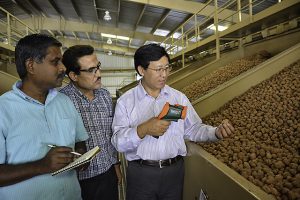
ARS engineer Zhongli Pan (right) and post docs Ragab Khir (center) and Chandrasekar Venkitasamy use an infrared thermometer to check walnut temperatures.
Photo by Mathew Reiff.
The popularity of walnuts is growing among health-conscious consumers, but processing these nutrient-vitamin-rich nuts could use some tweaking. Agricultural Research Service (ARS) scientists have developed a method that uses infrared technology to improve commercial processing, particularly drying, to reduce energy costs and deliver high-quality products.
Walnut drying is expensive and energy intensive, according to ARS engineer Zhongli Pan in Albany, California. The current hot-air drying method takes more than 24 hours to dry walnuts and uses a significant amount of natural gas and electricity. Infrared—a form of intense light that’s felt, but not seen—dries walnuts faster and is less expensive. It’s a type of electromagnetic radiation—as are radio waves, ultraviolet radiation, X-rays, and microwaves.
The new drying process, developed by Pan and his team at ARS’s Western Regional Research Center, includes three new steps: Hulled, in-shell walnuts are separated into two groups with different moisture contents; then pre-dried with infrared heating; and followed with regular hot air drying.
In experiments, the new process saved up to 25 percent of the natural gas and electricity needed to dry walnuts, according to Pan. In addition, the infrared drying process quickly removed moisture from the surface and shell of walnuts, reducing total drying time by 35 percent.
Walnuts have a broad range of moisture contents and get wet after washing, according to Pan. Currently they are hot-air dried for the same amount of time. This can cause under-drying or over-drying.
When the moisture content is too high, it causes mold, so facilities tend to over-dry walnuts to make sure they are safe to eat, Pan stated. But over-drying wastes a lot of energy and reduces walnut quality. Infrared drying improves quality by reducing both over-drying and under-drying, allowing walnut meat to maintain color and an exceptional polyunsaturated fat content.
This new infrared drying method also may be practical for other types of nuts, such as pistachios, according to Pan.
Read more about this research in the August 2017 issue of AgResearch magazine.
by USDA Agricultural Research Service










